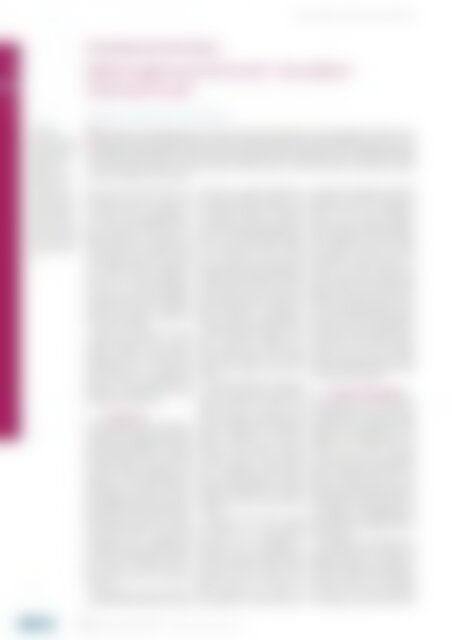Create successful ePaper yourself
Turn your PDF publications into a flip-book with our unique Google optimized e-Paper software.
<strong>atw</strong> Vol. 63 (<strong>2018</strong>) | Issue 8/9 ı August/September<br />
442<br />
FUEL<br />
Innovations for the Future<br />
Westinghouse EnCore® Accident<br />
Tolerant Fuel<br />
Gilda Bocock, Robert Oelrich, and Sumit Ray<br />
EnCore® and<br />
ADOPTTM are trademarks<br />
and registered<br />
trademarks of Westinghouse<br />
Electric<br />
Company LLC, its<br />
affiliates and/or its<br />
subsidiaries in the<br />
United States of<br />
America and may be<br />
registered in other<br />
countries throughout<br />
the world. All rights<br />
reserved. Unauthorized<br />
use is strictly prohibited.<br />
Other names<br />
may be trademarks of<br />
their respective owners<br />
The development and implementation of accident tolerant fuel (ATF) products, such as Westinghouse’s EnCore® Fuel,<br />
can support the long-term viability of nuclear energy by enhancing operational safety and decreasing energy costs. The<br />
first introduction of Westinghouse EnCore Fuel into a commercial reactor is planned for 2019 as segmented lead test<br />
rods (LTRs) utilizing chromium-coated zirconium cladding with uranium silicide (U 3 Si 2 ) pellets. The EnCore Fuel lead<br />
test assembly (LTA) program, with LTAs planned for 2022 insertion, will introduce silicon carbide/silicon carbide<br />
composite cladding with U 3 Si 2 pellets.<br />
Over the past several years, the<br />
Westinghouse EnCore Fuel features<br />
have been tested in autoclaves, in<br />
research reactors, at national laboratories<br />
and in the Westinghouse Ultrahigh<br />
Temperature Test Facility to<br />
confirm and fully understand the<br />
science behind ATF materials. Based<br />
on the positive results to date, fuel rod<br />
and assembly design in preparation<br />
for the LTR and LTA programs is<br />
underway, as well as licensing efforts<br />
with the U.S. Nuclear Regulatory<br />
Commission (NRC). Accident analyses,<br />
coupled with economic evaluations,<br />
have been continuing to define the<br />
value of ATF to utilities.<br />
These new designs will offer<br />
design- basis-altering safety, greater<br />
uranium efficiency and significant<br />
economic benefits. Adoption of the<br />
Westinghouse ATF, in conjunction<br />
with a transition to 24-month cycle<br />
operation, is the recommended path<br />
forward for implementation of the<br />
Westinghouse EnCore Fuel.<br />
1 Introduction<br />
Nuclear energy remains a fundamental<br />
component of many industrialized<br />
nations’ energy supply mixes due to its<br />
demonstrated reliability in baseload<br />
electrical supply, as well as inherent<br />
carbon-free energy production. Two<br />
factors are critical to maintaining this<br />
capability: (a) enhancing safety to<br />
help safeguard the plant and public<br />
from highly impacting events such as<br />
that which occurred at the Fukushima<br />
Daiichi Nuclear Power Plant and (b)<br />
decreasing operating costs to compete<br />
with other sources of energy. The<br />
development and implementation<br />
of Accident Tolerant Fuel (ATF) products,<br />
such as Westinghouse’s EnCore®<br />
Fuel features, can support both of<br />
these critical factors for long-term<br />
operation.<br />
Development of nuclear fuels with<br />
enhanced accident tolerance is being<br />
accelerated to support implementation<br />
into commercial reactors as soon<br />
as possible. The major objectives for<br />
ATF designs include: 1) improved<br />
cladding reaction to high-temperature<br />
steam; 2) reduced hydrogen generation;<br />
and 3) reduced beyond design<br />
basis accident source term. In addition<br />
to improving safety margins<br />
for light water reactors (LWRs), fuel<br />
designs using advanced, ATF materials<br />
can improve fuel efficiency, enhance<br />
debris resistance and extend fuel<br />
management capability. Encore Fuel,<br />
being developed by Westinghouse<br />
Electric Company LLC (Westinghouse),<br />
includes two unique accident tolerant<br />
or fault tolerant fuel designs: chromium<br />
(Cr)-coated zirconium (Zr)<br />
alloy cladding with uranium silicide<br />
(U 3 Si 2 ) fuel pellets, and silicon<br />
carbide (SiC) cladding with U 3 Si 2 fuel<br />
pellets.<br />
The first introduction of Westinghouse<br />
EnCore Fuel into a commercial<br />
reactor is planned for 2019 as segmented<br />
lead test rods (LTRs). The<br />
LTRs will utilize chromium-coated<br />
zirconium cladding with U 3 Si 2 highdensity,<br />
high-thermal conductivity<br />
pellets. The EnCore Fuel lead test<br />
assembly (LTA) program, planned<br />
for 2022 insertion, will introduce<br />
SiC/SiC composite cladding along<br />
with chromium- coated zirconium<br />
cladding and the high-density, /highthermal<br />
conductivity U 3 Si 2 pellets<br />
modified to achieve higher oxidation<br />
resistance.<br />
Over the past several years,<br />
Westinghouse’s ATF test program<br />
has tested the chromium-coated<br />
zirconium and SiC claddings in<br />
autoclaves and in the Massachusetts<br />
Institute of Technology’s (MIT) reactor<br />
and U 3 Si 2 pellets in Idaho National<br />
Laboratory’s (INL) Advanced Test<br />
Reactor (ATR). Tests in the Ultrahigh<br />
Temperature Test Facility at<br />
Westinghouse’s U.S. Materials Center of<br />
Excellence Hot Cell Facility in Churchill,<br />
Pennsylvania, have been carried out to<br />
confirm the time and temperature<br />
limits for the SiC and chromiumcoated<br />
zirconium claddings. Additionally,<br />
an extensive research program to<br />
fully understand the science behind<br />
ATF materials continues with the<br />
Westinghouse-led International Collaboration<br />
for Advanced Research on<br />
Accident Tolerant Fuel (CARAT) group<br />
and at United States (US) and United<br />
Kingdom (UK) national laboratories.<br />
Based on the positive results to date,<br />
fuel rod and assembly design in preparation<br />
for the LTR and LTA programs is<br />
underway, as well as licensing efforts<br />
with the U.S. Nuclear Regulatory Commission<br />
(NRC), and accident analyses<br />
coupled with economic evaluations<br />
for both operating savings and fuel<br />
savings have been continuing to define<br />
the value of ATF to utilities.<br />
2 Lead test rod program<br />
LTR programs are an essential step in<br />
the introduction of new nuclear fuel<br />
technologies into commercial energyproducing<br />
reactors. In the EnCore LTR<br />
program, two Westinghouse 17x17<br />
optimized fuel assemblies (OFA) will<br />
contain up to 20 ATF rods with<br />
Cr-coated Zirconium alloy cladding,<br />
and U 3 Si 2 and enhanced ADOPT fuel<br />
pellets in Exelon’s Byron Unit 2 in<br />
Cycle 22. Coated tubes and U 3 Si 2 and<br />
ADOPT pellets will be delivered to the<br />
Westinghouse Columbia Fuel Fabrication<br />
Facility for manufacturing of<br />
the assemblies. The shipping date for<br />
the assemblies containing the LTRs is<br />
February, 2019.<br />
Westinghouse is continuing development<br />
work with the University of<br />
Wisconsin-Madison to continue the<br />
optimization of coating performance,<br />
and also working with commercial<br />
vendors and the U.S. Army Research<br />
Lab (ARL) to scale-up production<br />
to full-length tubes. The U 3 Si 2 fuel<br />
Fuel<br />
Westinghouse EnCore® Accident Tolerant Fuel ı Gilda Bocock, Robert Oelrich, and Sumit Ray

















